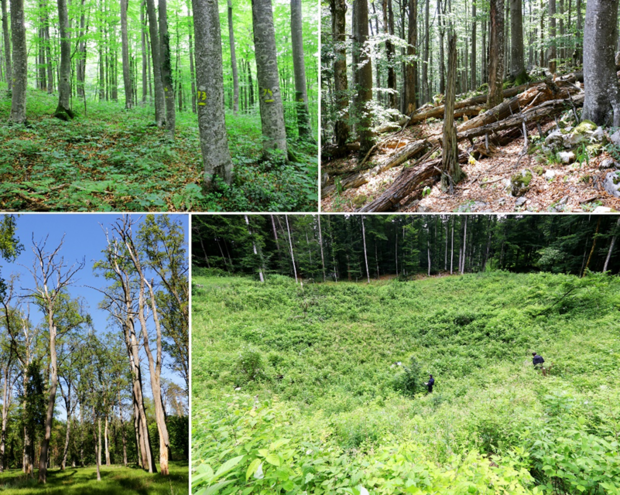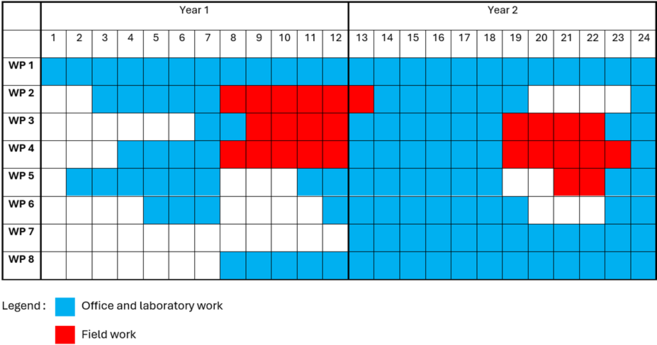About the project
Project number: Z4-4543
Project duration: 24 months, 01.10.2022 - 30.09.2024
Financing: ARIS
Lead partner: Slovenian Forestry Institute
Abstract & project overall objective
Global, regional, and local environmental changes that trigger processes of thermophilization, ruderalization, eutrophication, and homogenization of vegetation have the potential to seriously threaten the sustainability of forest plant communities. The impacts of these changes and processes on forest vegetation remain largely unknown and understudied in Slovenia. To identify vegetation responses to changes in environmental factors, a wide range of different forest stands and the use of relevant data over longer time periods are required.
The objective of the postdoctoral research project is to analyse the direction, trend, and magnitude of changes in forest vegetation in Slovenian and European forests over the last decades. The aim is to ascertain whether the effects of changing global and local factors are reflected in the dynamics of forest vegetation. The project's objectives are to identify the following:
1. The contribution of climate change to the process of forest vegetation thermophilization.
2. The contribution of forest disturbances to the process of vegetation ruderalization.
3. The contribution of atmospheric deposition of nitrogen compounds to vegetation eutrophication.
4. The contribution of climate change, forest disturbance, nitrogen deposition, the spread of invasive non-native species, and herbivore browsing to a potential process of biotic homogenization in the species composition of forest communities.

Project work plan & activities
The project investigates the impact of environmental change on vegetation in a range of forest ecosystems across Slovenia. These include lowland oak forests, beech-dominated and mixed forests, and alpine spruce forests. In order to accurately identify and assess the impact of environmental change on forest vegetation, it is essential to consider a range of sites with diverse ecological backgrounds and vegetation conditions. To this end, the study will select a representative set of research plots, where vegetation surveys will be adequately complemented by field measurements of different ecological parameters (soil conditions, forest microclimate).
The study sites selected for the project include:
a) A representative set of permanent research plots established in the early 1990s in oak forests dominated by Quercus robur and Quercus petraea.
b) Semi-permanent vegetation plots in beech (Fagus sylvatica) old-growth forest reserves and in oak-hornbeam primeval forest reserve, which were established 40-50 years ago.
c) Research plots in various stand situations (canopy gaps, thinned stands, control) in Dinaric fir-beech forests (Omphalodo-Fagetum), designed to trace the natural vegetation succession after management disturbance.
d) Permanent plots for intensive monitoring of different forest ecosystems in Slovenia, which are part of the European ICP-Forests network.
e) Monitoring plots within the International Monitoring Programme (ICP-Forests database), in order to verify and compare the effects of environmental change on forest vegetation at a European scale.
The research project is organised in several work packages (WPs), the planned implementation of which is outlined in figure below.
WP 1: Project management and communication.
WP 2: Implementation of Task 1 - Vegetation surveys and forest soil sampling in permanent research plots in oak forests.
WP 3: Implementation of Task 2 – Field sampling of vegetation in semi-permanent plots in selected forest reserves (montane beech and lowland oak forests).
WP 4: Implementation of Task 3 - Vegetation inventories and measurements of forest microclimate and eco-physiological parameters in permanent research plots in the Dinaric fir-beech forests.
WP 5: Analysis of the data obtained from Tasks 1-3 and from the Intensive Monitoring of Forest Ecosystems in Slovenia (Task 4) plots. Application of different aspects (taxonomic, functional and phylogenetic aspects) and linkage of forest vegetation with ecological factors.
WP 6: Implementation of Task 5 - Acquisition and analysis of vegetation data from the ICP-Forests database, a pan-European forest monitoring programme.
WP 7: Synthesis of key findings and predictions (modelling) of future forest vegetation development.
WP 8: Dissemination of project results: presentation at international conferences and publication in scientific articles.


